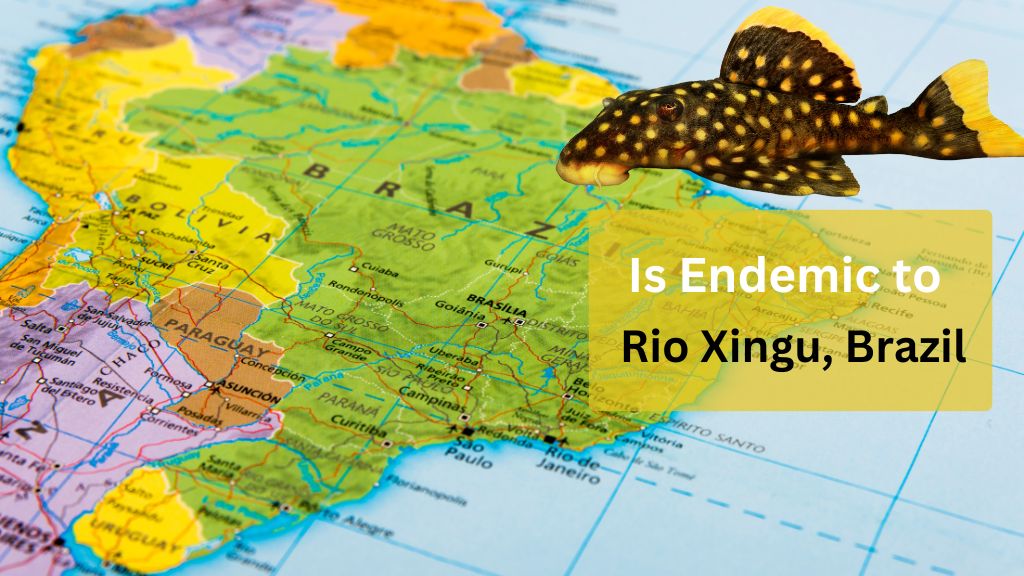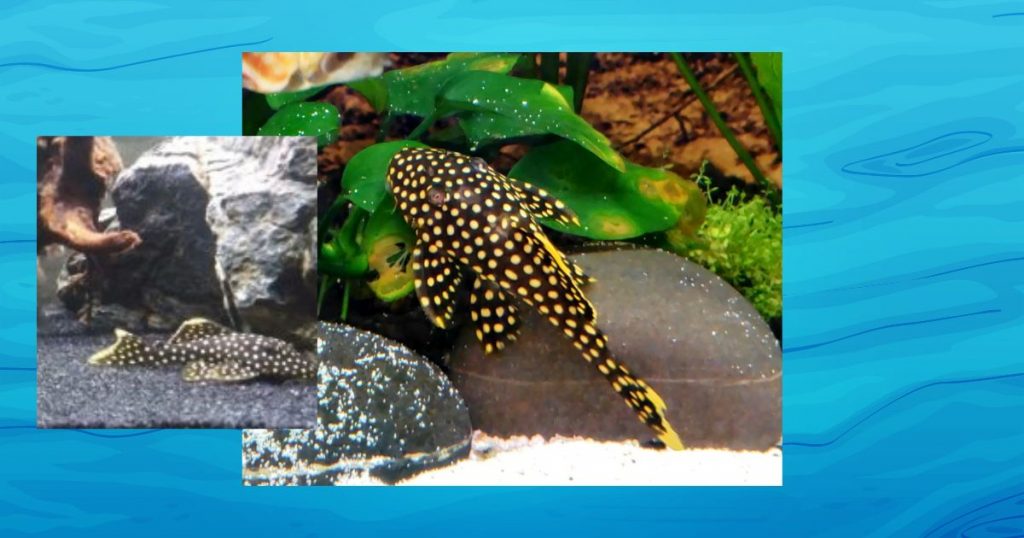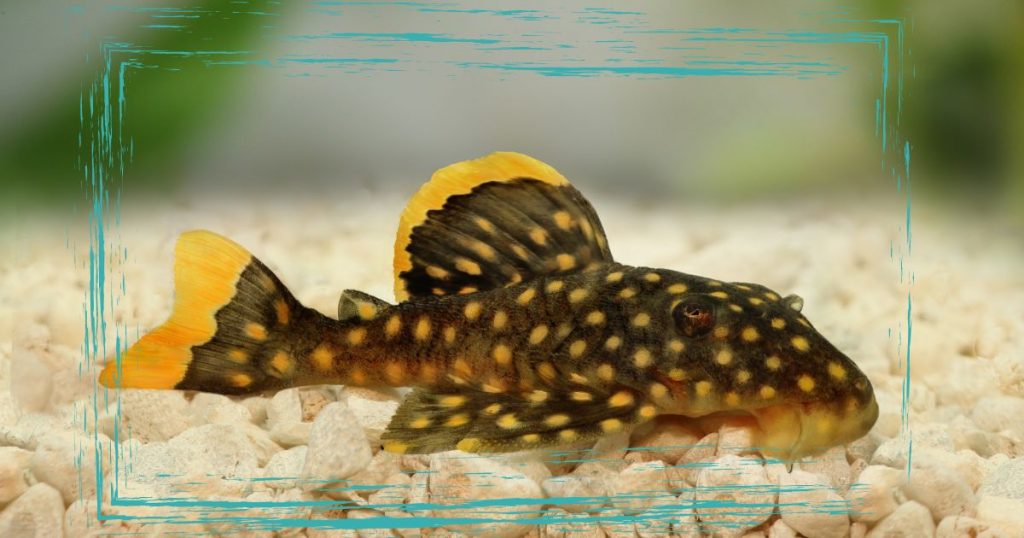I have used Amazon affiliate links on this page. As an Amazon Associate, I earn a commission from qualifying purchases at no added cost to you. Thank you!

By Anne Blindheim – Anne Blindheim, CC BY-SA 3.0, Link
Only found in Brazil, the Gold Nugget Pleco (scientifically known as Baryancistrus xanthellus) is a reasonably well-known pleco species. This species is frequently referred to as the Golden Nugget Pleco, albeit the “Gold Nugget Pleco” variant is more prevalent.
The appearance of gold nugget plecos is a nice change from that of regular plecos. The typical picture that comes to mind when we think of a pleco is that of a dull fish.
Moreover, not only is this species incredibly attractive visually, but maintaining them is also very simple. They are trouble-free in your aquarium and require very little maintenance.
Compared to many other catfish, the gold nugget pleco is less tolerant of unfavorable water quality. Many are brought home with the naiveté believing they will “clean the glass” and just require a minimal amount of care and attention. The gold nugget pleco, like many other “fancy” pleco species, will not thrive unless given special attention. They are an omnivorous species, therefore provide prawns, bloodworms, and mussels in addition to algae wafers and fresh veggies. This nocturnal species has a better chance of getting food if it feeds after dark.
Table of Contents
Natural Distribution and Habitat of Gold Nugget Pleco

The various varieties of gold nuggets are indigenous to the stony rapids of the Rio Xingu in Brazil, specifically in its downstream sector, Volta Grande do Xingu, and a region just above Belo Monte falls as well as from Rio Irir, a sizable tributary of Rio Xingu.
They love to live in fast flowing water which is warm, usually around 30 degrees. Even as adults, fish prefer to stay in shallow waters. The fish love this habitat because they eat algae and biofilm that grows on rocks in these warm waters.
Young fish have been seen to gather under flat rocks at the bottom of shallow stretches, while adults are typically located under and around submerged rocks and boulders. These fish are most common in whitewater rapids.
Gold Nugget Taxonomy
Ichthyologists, or people who study fish, are still working to categorize the various species of plecostomus. There are hundreds of species, many of which are quite closely related, which is the problem. Even for them, it’s challenging to distinguish which are merely color variants, which are subspecies, and which are actually distinct.
However, the Loricariidae family, which belongs to the genus Baryancistrus, is where the Gold Nugget Plecostomus belongs. The suckered jaws of loricariids, commonly referred to as “armored catfish,” allow them to grasp onto rocks while eating algae.
The Gold Nugget Pleco was previously identified by a variety of “L” and number suffixes. The letter “L” stands for Loricariidae, and the number assigned to each type follows. The “L” method was created to prevent confusion between the many kinds of Gold Nuggets, and it is still frequently used today for practical reasons.
Consequently, the 1981 description of the gold nugget pleco used the L-number method. It is frequently referred to as L018 or L-18, indicating that it is the 18th species in line for official classification.
The Varieties of Gold Nugget Pleco
The Gold Nugget Pleco comes in three different varieties: L18 (Big Spot Gold Nugget Pleco), L85 (Fine Spot Gold Nugget Pleco), and L177 (Goldseam Gold Nugget Pleco). The L18 is undoubtedly the most well-liked of the three varieties.
Appearance

Because of their unique form and color pattern, Gold Nugget Plecos frequently pique the interest of aquarists. When compared to many of their relatives, this makes them quite the standout.
They feature bright markings and a dorsal fin shaped like a fan. Gold nugget plecos are among the most beautiful freshwater fish, but they are also more expensive than most other plecos.
As we all know, the majority of catfish species can have really unattractive appearances, and not everyone finds the suckermouth appealing. However, the Gold Nugget Pleco appears to be swimming down the runway at the most recent fashion show. It has a body that ranges from dark green to black and is coated with evenly placed yellow spots. The caudal and dorsal fins’ tips also have yellow bands around them.
Special Features
The Gold Nugget Pleco has the typical Loricariid shape and build, as with any armored catfish. It also includes a mouth that is vertically angled and designed to scrape algae and other microbes that grow on rocks. Its head is angled downward toward the ground for effective scavenging.
Starting at the caudal peduncle, the body begins to narrow down and enlarge from the pectoral fins to the eyes. Particularly while they are resting, this species has broad pectoral fins that point backward. Its fan-shaped dorsal fin is slightly bigger than its asymmetric caudal fin.
Gold Nugget Pleco Size
The maximum length of the Big Spot Gold Nugget Pleco and Goldseam Gold Nugget Pleco are 9 inches. The largest of them all is the Fine Spot Gold Nugget Pleco, which may reach a maximum length of 12 inches. Like any captive species, its development rate is determined by the standard of the food, the state of the water, and the confines of the area.
As a result, they have a maximum length of 13 inches living in their natural habitats in South America.
Gold Nugget Pleco Water Parameters
As was said at the outset of this essay, tropical freshwater ecosystems are home to Gold Nugget plecos. Therefore, the home aquarium’s water temperature range should be 25 to 29 degrees Celsius. Between 6.5 and 7.5 is the ideal pH range for Gold Nugget plecos, and 2 to 15 dGH is the ideal range for water hardness.
Aquarium Water Testing Kits
Aquarium Heaters:
Thermometers
Aquarium Wave Makers
| Minimum Tank Size for One Specimen | 55 gallons |
| Temperature | 77 to 84 F |
| Hardness | 5 – 15 dGH |
| pH | 6.5 to 7.5 |
Gold Nugget Pleco Tank Size Vs Their Growth
Its capacity for growth will expand by providing a bigger tank. Growth will be inhibited in a smaller tank with many other residents. An aquarium with a minimum capacity of 55 gallons is suggested for Gold Nugget Plecos, according to specialists. A 100-gallon or 150-gallon tank is needed to keep multiple and other communal fish species with them.
Gold Nugget Pleco Diet
Although Gold Nugget Pleco are omnivores, they favor plant-based diets more often. They will also consume tiny creatures, crabs, and insect larvae in modest quantities. Hence, fresh plants and algae make up the majority of their diet in the wild.
Replicating their natural food habits is the best way to keep these fish healthy and long living.
Therefore, their daily diet should also include fresh veggies. These include zucchini, spinach, cucumber, carrots, and sweet potatoes are some examples of fresh veggies that are excellent providers of nutrition.
But unluckily, the majority of hobbyists only feed them high-protein, commercially produced foods, which can shorten the lifespan of gold nugget plecos. Although these live and frozen foods are excellent sources of protein, you should only feed them occasionally. However, this pleco can be fed on daphnia, brine shrimp, bloodworms, tubifex worms, and other kinds of small fresh or frozen foods. But remember to feed them these food as snacks and remove any left overs as they can quickly contribute to damage the balanced nitrogen cycle in your aquarium.
Tank Mates and Temperament

Larger aquariums are required to keep gold nugget pleco alongside other tank mates. When it comes to securing a nice hiding area, this plecostomus species has a reputation for being extremely possessive toward other fish.
Although gold nugget plecos cannot bite, they will flash their huge pectoral fins as a sign of aggression and will push other fish away if they feel that their personal space is being invaded. Otherwise, especially with a large tank size, they are quite good at keeping to themselves.
Therefore, keeping a Gold Nugget Pleco apart from other plecos is wise as they will fight for same spaces in the aquarium. As mentioned above they don’t get along with other catfish and can be extremely territorial when sharing their hiding places. Hence, the trick is to add some species that roam in the middle and top levels of the tank while giving the Gold Nuggets free rein on the bottom. Additionally you may provide more hiding places and extra space if you are intend to keep other pleco species with them.
When fed frequently, these fish do well with various varieties of snails, unless Gold Nugget Plecos are known to eat them.
Good Tank Mates
- Tetra Species – Ember Tetra, Neon Tetra, Rummy Nose Tetra, Black Widow Tetra, Red Phantom Tetra
- Gourami Species – Honey Gourami, Sparkling Gourami, Pearl Gourami, Dwarf Giurami
- Types of Goldfish – Oranda, Ranchu, Lionhead, Black Moore, Pearlscale, Fan
- Danios – Celestial Pearl Danio, Zebra fish, Spotted Danio
- Cichlids – Apistogramma, African Cichlid, Taiwan Reef Cichlid, Red Empress Cichlid
- Mollies, Platies, Swordtails
- Angelfish
- Guppies
- Barbs Species – Tiger Barbs, Black Ruby Barbs, Rosy Barbs
Aqua scaping a Gold Nugget Pleco Tank

Consider the kind of waters in which a Gold Nugget Pleco is likely to be found in the wild, as well as how they interact with their surroundings, while setting up the tank for one.
You don’t necessarily need a lot of additional swimming room because gold nugget plecos don’t have a particularly active lifestyle. In actuality, these timid fish like a lot of vegetation, debris, and hiding spots.
Since your gold nugget pleco will always feel exposed and vulnerable in a brightly illuminated tank, it tends to stress them out. In their native habitat in South America, the water is frequently dark and stained with tannins from decaying plants and wood.
Substrate

Typically, a typical sandy substrate is best. The majority of their time will be spent at the tank’s bottom. Anything irritating or abrasive will not only make them more anxious overall, but it also runs the risk of causing cuts and infections.
Hiding Places
Golden Nugget Plecos continually employ different types of refuge to keep safe because of their natural habitat and how they interact with their environment. In South American rivers there are lots and lots of predators that can eat this fish, including piranhas, river dolphins, arapaima, Hoplias aimara or wolf fish etc. Apart from predatory fish there are other predators like caimans, birds and river otters.
This implies that objects like driftwood, boulders, and caves can all be taken into account. Adding these have more benefits like collecting algae, providing breading grounds for smaller fish, and adding more surface area for bacteria to grow, etc.
Plants
The tank should have an average amount of flora and plant life. This will assist in controlling the light that penetrates to the bottom. Additionally, plants will absorb nitrate and ammonium, enhancing the water’s overall quality.
Moreover, falling off plant materials and leaves are an additional food source of the Gold Nugget Pleco.
Gold Nugget Pleco Breeding
Since they haven’t been bred in captivity to anyone’s knowledge, gold nugget pleco breeding is sadly mostly a mystery. Each and every fish kept as pets is a wild-caught individual.
Moreover, they are considerably trickier to sex visually because they aren’t highly sexually dimorphic. The cheek spines of several of the other pleco species in the baryancistrus/ancistrus genus are extended in males.
However, they reproduce in the wild in a manner that is typical of most other pleco species. The great majority of species are seasonal cavity spawners.
How Gold Nuggets Spawn In The Wild
Other plecos will spawn there when they have managed to lure a willing female in, and one or both parents will keep watch over the eggs until they hatch.
The baby plecostomus then consume all the nearby algae while distancing themselves from their nest until they are left to live alone as solitary fish.
Gold Nugget Pleco Diseases and Prevention
The toughest fish species is the Gold Nugget Pleco. Nevertheless, an aquarium is a small area, thus fish cannot escape diseases if you are not care enough, and this include Gold Nugget Pleco as well. Hence, these fish will suffer in an unbalanced aquarium and will be more susceptible to illness than the ones you find in the wild. Moreover golden nugget may likely to get sick if you add new fish that are disease-carrying without quarantining then beforehand.
Internal ailments, worms, and Ich are the most prevalent types of disease in gold nugget plecos. Make sure to constantly quarantine new fish and plants before adding them to your pleco tank because these diseases can spread readily from fish to fish and tank to tank.
By keeping the tank clean, you can stop the worm and other diseases from naturally appearing there. The majority of infections in aquariums are mostly caused by low water quality. For the fish in your tank to be as healthy and happy as possible, weekly water changes are usually recommended.
Special Care Tips
When keeping gold nugget plecos, hobbyists should have a sizable aquarium and a powerful filter. Because of their potential sensitivity to high concentrations of nitrogenous waste products, these wild-caught fish, this is.
Ammonia, nitrite, and nitrate are three types of water contaminants that are created when tank habitants emit waste. Ammonia will be transformed into nitrite and then back into nitrate by the helpful nitrifying bacteria in a good cycled aquarium with a sufficient filtering system.
FAQs about Gold Nugget Pleco
Are tanks cleaned by Gold Nugget Plecos?
Many think they can use Gold Nuggets to keep their tanks spotless. The fish will certainly rasp the algae, but they aren’t the most efficient scavengers. In contrast to other plecostomus species, they won’t eat fish waste and other aquarium trash.
How aggressive are golden nugget plecos?
Because they aren’t particularly aggressive, gold nugget plecos can be kept in tanks with fish of almost any size or species. But because they are territorial, they will protect their preferred hiding places from trespassers.
Maximum size Gold Nugget Pleco reach and which variant?
The Fine Spot Gold Nugget Pleco, which may grow to a maximum length of 12 inches, is the biggest of them all.